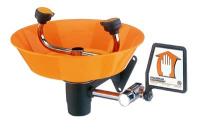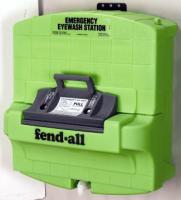EMERGENCY FACE/EYE WASH/SHOWER REQUIREMENTS
EYEWASH STATION REQUIREMENTS
Resource Center Topics
Coronavirus Information
Ebola Information
Ebola Virus Information
Ebola Donning
Ebola Doffing & Disposal
Hearing Protection
Avian Bird Flu Information
Chemical Safety
General Workplace Safety
Basic First Aid
Ergonomics
OSHA Checklist for General Industry
Welding Safety
Healthcare/Laboratory
Electrical Safety
Eyewash Station Introduction
Experts agree the most important first aid procedure for eye and skin contact with hazardous materials is abundant irrigation within seconds. The need for immediate flushing requires the installation of emergency eyewash and shower devices in accessible locations that require no more than 10 SECONDS to reach. Studies have shown there is a significant difference in the outcome of chemically burned eyes and skin tissue that receive prompt irrigation and those that did not undergo immediate flushing - patients required less surgery, had shorter hospital stays, and faster recoveries.
The type of emergency eyewash and shower device, and the maintenance of that device can greatly affect the treatment and eventual recovery. Safety professionals can choose from a variety of emergency eyewash stations, emergency showers, and combination emergency eyewash and shower devices. The primary eyewash unit required for a hazard area must meet the requirements set by ANSI Z358.1-2004. Eyewash stations and bottles that supply less than the minimum flushing requirements of ANSI Z358.1-2004 are intended to support, not replace, primary units. These supplemental or personal eyewash units are referred to as secondary devices.
OSHA Regulations state in 29 CFR 1910.151: "Where the eyes or body of any person may be exposed to injurious corrosive chemicals, suitable facilities for quick drenching or flushing of the eyes and body shall be provided within the work area for immediate emergency use."
Another consideration for selection of emergency eyewash and emergency showers are the Material Safety Data Sheet (MSDS) for the chemicals used in your facility. The MSDS provides information about that chemical's potential health hazards and contains emergency and first aid procedures to follow immediately after exposure, until medical help arrives. The MSDS will normally state if an emergency eyewash and/or emergency shower is required
OSHA enforces the ANSI Z358.1-2004 standard that contains provisions regarding the design, performance, installation, use and maintenance of various types of emergency equipment (showers, eye washes, drench hoses, etc.).
The following specifications are taken directly from the ANSI Z358.1-2004 standard
SHOWERS
(Same for Stand Alone Emergency Shower and Combination Safety Stations
Plumbed Shower:
An emergency shower permanently connected to a source of potable water.
Self-Contained Shower: A shower that contains its own flushing fluid, and must be refilled or replaced after use.
The specifications below are for plumbed showers only.
- Heads
- Valves
- Installation
- Maintenance and Training
PERSONAL EYE WASH
A supplementary eye wash that supports plumbed units, gravity-feed units, or both by delivering immediate flushing fluid.
NOTE: Personal eye wash units can provide immediate flushing when they are located near the workstations. Personal eye wash equipment does not meet the requirements of plumbed or gravity-feed eye wash equipment. Personal eye wash units can support plumbed or gravity-feed eye wash units, but cannot be a substitute.
Frequently Asked Questions
Q.
What is 10 seconds travel time?
A.
The ISEA recommends the following for locating eyewashes and showers. Travel distance: The reference to a specific distance for placement of emergency equipment has been removed to place emphasis on the time that it should take to research the equipment. Consideration to lighting and path of travel should be given. In no situation should it take more than 10 seconds to reach the equipment and it should be noted that such equipment must be located on the same level as the hazard and the path of travel shall be free of obstruction. At this time, the Secretariat is not recommending a specific measurement of travel relative to a 10 second travel time.
Q.
Why is tepid water required and who requires it for eye washes and showers?
A.
ANSI Z358.1 requires the use of tepid water for emergency showers & eyewashes. It is important to provide tepid water to showers and eyewashes so that a user has the ability to use the equipment as designed. Cold water may cause the user to abort use of the equipment before all contaminants can be removed. Additionally victims subjected to cold water may experience hypothermia. Water that is too warm may cause a thermal burn and additional injury to the eyes or body.
Q.
Are there any recommended procedures on how to effectively flush eyes that have been contaminated?
A.
Individuals should be instructed to hold the eyelids open and roll the eyeballs so fluid will flow on all surfaces of the eye and under the eyelid.
Q.
Are there any alternatives to the frequent changing of gravity-fed eyewash solutions?
A.
Yes. Factory-sealed cartridges containing eyewash solutions are available. These products have shelf lives well in excess of preservative solutions and are significantly easier to maintain.
Top Selling Eyewash Systems
Sources for More Information
29 CFR 1910.151(c)
ANSI Z358.1-2004
American National Standards Institute
11 W. 42nd St.
New York, NY 10036
(212) 642-4900
Please Note: The information contained in this publication is intended for general information purposes only. This publication is not a substitute for review of the applicable government regulations and standards, and should not be construed as legal advice or opinion. Readers with specific questions should refer to the cited regulation or consult with an attorney.
Return to customer center


